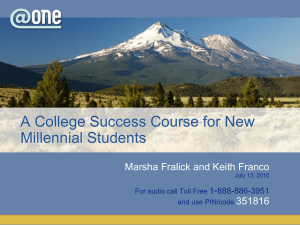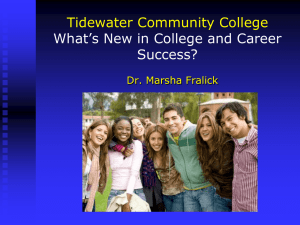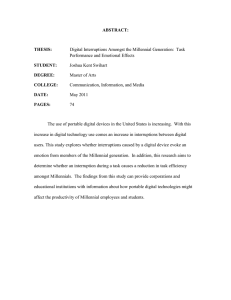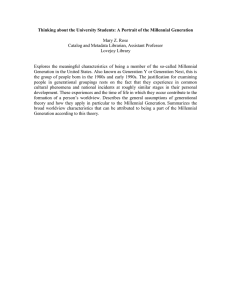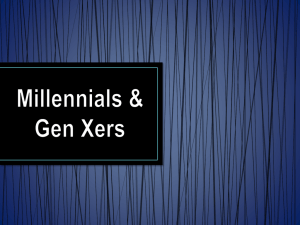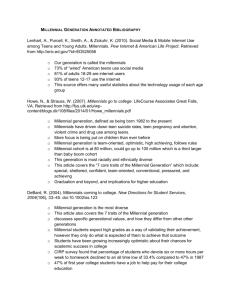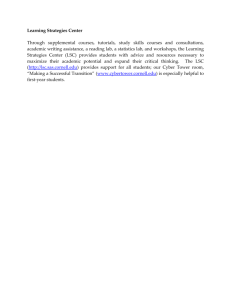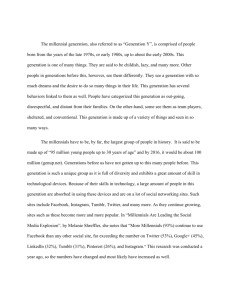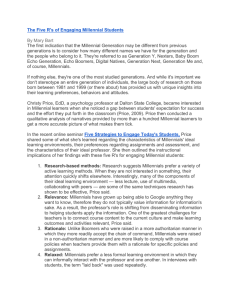Name of Presentation
advertisement
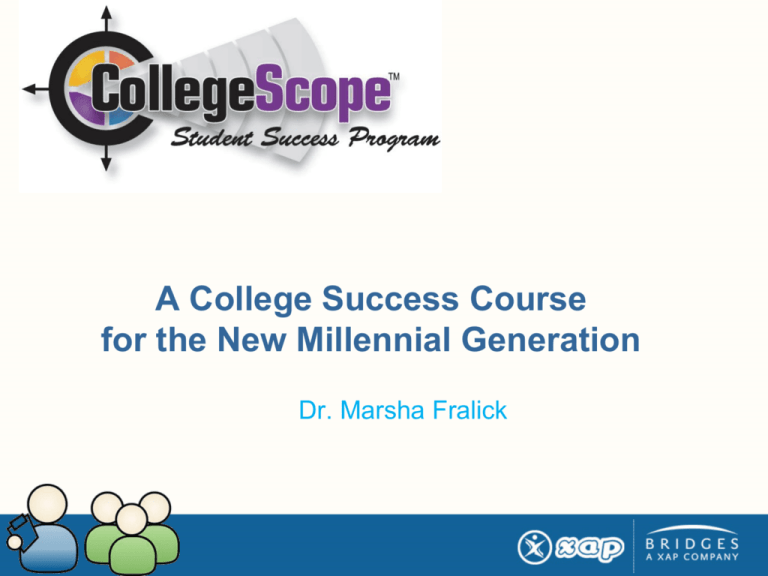
A College Success Course for the New Millennial Generation Dr. Marsha Fralick Ice Breaker Think, Pair, Share Introduce yourself. Where are you from? If I were to visit your city, what is one place I should make sure to see? Overview • Characteristics of the New Millennial Generation • Using technology to engage New Millennials • Retention results • Example: College Success at Cuyamaca College Going Green! All handouts are located at: http://www.collegesuccess1.com/Conferences.htm New Millennials • Our current college students were born after 1992. • Most were born with a computer in the home and were using them by age 5 • The connected generation • 82% are online daily • Average 12 hours per week online Some Facts from Pew Research • They are generally happy with their lives and optimistic about the future • Unique appearance 54% have tattoos, hair dyed an unnatural color or body piercings other than ear lobes • Their top goals are fame and fortune Use Technology to Connect • 50% send or receive a text message daily • 29% use instant messages daily • 44% have a profile on Facebook or My Space and 38% use them daily Maintain Close Contact with Family • 82% talked with a parent yesterday • 45% speak by phone with parents daily • 75% say parents helped them financially in the last year • 64% got help from parents to run errands, help with housework or home repairs in the last year Technology: The Good • Makes people more efficient • Makes you closer to friends and family • Makes it easier to make new friends What is the bad? Technology: The Bad What did this group report to Pew research? • Makes people lazier (84%) • Makes people more isolated (67%) • Makes people waste time (67%) These New Millennial students are now being called Generation E • What does the “E” stand for? New Millennials or Generation E • 18-30 years old • Empowered • Entitled • Electronic – Leading change from paper to electronic media Being in the Millennial Generation, I did start using computers as a young child. I learned how to spell with the help of computers and how to read with computerized books. Computers have always been a part of my life, which is probably why I am so drawn to them. Dawn Cardenas College Success Student Introduce yourself. Where are you in the technology continuum? • • • • Baby boomer 1946-1964 Generation X 1965-1977 New Millennials 1977-1995 How much technology did you use in college? Why is the world flat? Three Great Eras of Globalization • 1492 Columbus set sail to find new trade routes – the earth is round • 1880-2000 Industrial Revolution – Railways, highways and communication makes the world smaller Globalization 3.0 • Began in 2000 • Convergence of the computer and fiber optic cable that enables global collaboration and competition • The flat world Rapid Change • Berlin Wall fell in 1990 • World Wide Web created in 1991 • Windows, Netscape and Internet Explorer invented 1995 • Google invented 1998 • iPhone invented 2007 Skills Needed for the Flat World • • • • • • • Reading Computer skills Math Science Learn how to learn Intrinsic motivation People skills • Passion and curiosity • Being able to navigate the virtual world • Be a good adapter, synthesizer and collaborator • Appreciation of diversity What Comes Next? Hippies Yuppies Zippies How can we help New Millennial college students be successful? • Think • Pair • Share A College Success Course for the New Millennial Generation Keys to Success • Use technology to make education engaging and inescapable. Technology • Most college courses, especially upper division courses, have online components • Working in an online environment is essential for high paying careers • Students are disadvantaged if they do not have access to the Internet and are skilled in using it Rationale for Using Technology • • • • • Improves retention and success New roles for faculty Your students use it It captures their attention Education any time or place Using Technology • Online career and learning style assessment • E-text • Online portfolio • Engaging material for the New Millennial generation Take a Look Results: Cuyamaca Community College Implementing CollegeScope resulted in a 26% increase in fall to spring persistence! Results: Lone Star College System Persistence rate of all Student Types Persistence rate of CollegeScope students LSC – CyFair 79% 94% LSC – Kingwood 67% 82% LSC –Montgomery 77% 88% LSC – North Harris 81% 90% LSC – Tomball 70% 82% System Average 75% 87% College College Success: A Study of Positive and Negative Attrition Community College Review The Successful Student • Had a definite goal or college major Based on this research, choosing a major and career planning was included in our college success course. Keys to Success • The program helps students to make a good choice of a major and career. How did you choose your major? Career? •Carl Jung and personality type Online: Key to Success: Make it Count • Transfers as general education for CSUC, Area E, Lifelong Understanding • Transfers to University of California • 3 units Keys to Success • The program helps students to understand their learning style and how to become a lifelong learner. The PEPS Learning Style Assessment • Measures preferences in 20 areas – Perceptual – Environmental – Emotional – Sociological – Physical Cuyamaca College El Cajon, CA Personal Development 124, Lifelong Success • 8000 students enrolled in college • 1600 take PDC 124 each year • One of the top 15 revenue producing programs for the college • 56 sections a year College Success Motivation Time and Money Memory and Reading Test Taking Taking Notes, Writing and Speaking Career Success Personality and Related Majors Learning Style and Intelligence Interests and Values Career and Educational Planning Lifelong Success Communication and Relationships Critical and Creative Thinking Maintaining a Healthy Lifestyle Appreciating Diversity Positive Thinking Life Stages Course Choices • Face to Face – 22 sections • Blended – 22 sections • Online – 12 sections Bridge High School Community College University Resources for Faculty www.collegesuccess1.com • Instructor Manual – Exercises and Handouts • • • • Syllabus Research PowerPoint Internet Links • Questions? • Evaluation forms
